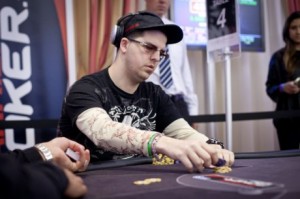Sometimes opponents allow you to win a pot when they clearly should not. I recently played this hand in a $1,500 preliminary event. A player who had been fairly aggressive from late position raised to 1,600 out of his 35,000 stack at 300-600-100 in the cutoff seat. A loose-passive, weak player with 40K chips called on the button. I am fairly confident they could both have a wide range since they’re both loose. I expect the initial raiser to have a decent mix of monsters and medium-strength hands in his range while the caller should have mostly medium-strength hands, as he didn’t reraise. I elected to make it 6,600 out of my 50,000 stack from the big blind with  –
– . Both players called.
. Both players called.
With a hand like Q-10 out of position, reraising is almost always a better play than calling because when you call, you have to hit the flop to win. When you reraise, you give yourself the chance to win preflop as well as postflop with a bluff. I was quite surprised to see both opponents call, although once the initial raiser calls, the loose, passive button will probably continue with every hand he called the initial raise with.
The flop came  –
– –
– . I bet 7,000, the initial raiser called and the button folded. My plan here was to make a cheap stab at the pot and fold if either player pushed. If either player called, my plan was to shut down on the turn unless I improved my hand. The initial raiser surprised me again by just calling, as most players would push or fold on the flop. I generally expect the initial raiser to show up with a king, J-10 or maybe a hand such as Q-J. I’m in terrible shape against most of this range, which means I should give up on the pot. If my opponent’s range had a decent amount of draws in it or hands like 6-6, I could go into bluff-catching mode, but since I think he would fold the small pairs and can’t have many draws, my only play is to give up, despite holding middle pair.
. I bet 7,000, the initial raiser called and the button folded. My plan here was to make a cheap stab at the pot and fold if either player pushed. If either player called, my plan was to shut down on the turn unless I improved my hand. The initial raiser surprised me again by just calling, as most players would push or fold on the flop. I generally expect the initial raiser to show up with a king, J-10 or maybe a hand such as Q-J. I’m in terrible shape against most of this range, which means I should give up on the pot. If my opponent’s range had a decent amount of draws in it or hands like 6-6, I could go into bluff-catching mode, but since I think he would fold the small pairs and can’t have many draws, my only play is to give up, despite holding middle pair.
The turn was the beautiful  . Seeing how the initial raiser only had 20,000 chips left and there was 35K in the pot, I decided to go all-in. I don’t really see how he can fold any hand he called with on the flop, as even J-10 made a pair and is getting decent odds. He instantly called with A-Q and I won a nice pot.
. Seeing how the initial raiser only had 20,000 chips left and there was 35K in the pot, I decided to go all-in. I don’t really see how he can fold any hand he called with on the flop, as even J-10 made a pair and is getting decent odds. He instantly called with A-Q and I won a nice pot.
You should notice in this hand that if my opponent went all-in preflop or on the flop, he would’ve forced me off my hand and picked up a nice pot. Instead, he allowed me (and the button) to see a cheap flop, which gave both of us a chance to outdraw him. While I’m all for letting your opponents stay in the hand when they’re drawing to three outs, if the pot is large preflop and you have a hand that’s decently strong, you should basically always try to pick up the dead money. Also notice if the flop were K-9-3 instead of K-Q-3, I would’ve made the same continuation bet and probably forced my opponent off his A-Q. My opponent turned a super profitable push preflop, which would have allowed him to profit 7,500 chips, with little risk, into a disaster where he went broke.
Putting yourself into simple spots in tournaments is a way to avoid trouble and, in this spot, my opponent did the opposite. When you have a strong hand in a tournament and there’s a lot of money in the pot preflop, don’t be scared to take a little risk and go all-in.
— Jonathan Little is the Season 6 WPT Player of the Year and is a representative for Blue Shark Optics. If you want to learn to play a loose-aggressive style, which will constantly propel you to the top of the leaderboards, check out his poker training website at FloatTheTurn.com.




